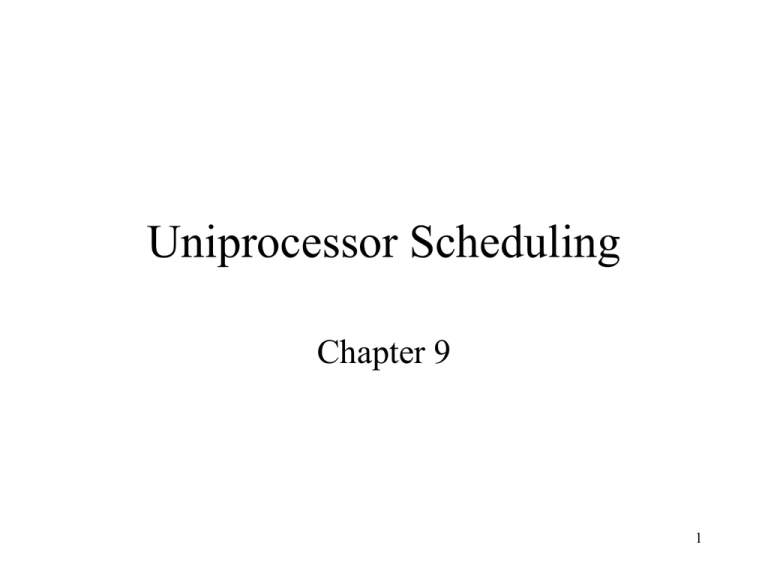Uniprocessor Scheduling Chapter 9 1
advertisement

Uniprocessor Scheduling Chapter 9 1 Aim of Scheduling • Assign processes to be executed by the processor(s) • Response time • Throughput • Processor efficiency 2 3 4 5 Long-Term Scheduling • Determines which programs are admitted to the system for processing • Controls the degree of multiprogramming • More processes, smaller percentage of time each process is executed 6 Medium-Term Scheduling • Part of the swapping function • Based on the need to manage the degree of multiprogramming 7 Short-Term Scheduling • Known as the dispatcher • Executes most frequently • Invoked when an event occurs – – – – Clock interrupts I/O interrupts Operating system calls Signals 8 Short-Tem Scheduling Criteria • User-oriented – Response Time • Elapsed time between the submission of a request until there is output. • System-oriented – Effective and efficient utilization of the processor 9 Short-Term Scheduling Criteria • Performance-related – Quantitative – Measurable such as response time and throughput 10 11 12 13 Priorities • Scheduler will always choose a process of higher priority over one of lower priority • Have multiple ready queues to represent each level of priority • Lower-priority may suffer starvation – Allow a process to change its priority based on its age or execution history 14 15 Decision Mode • Nonpreemptive – Once a process is in the running state, it will continue until it terminates or blocks itself for I/O • Preemptive – Currently running process may be interrupted and moved to the Ready state by the operating system – Allows for better service since any one process cannot monopolize the processor for very long 16 Process Scheduling Example 17 First-Come-First-Served (FCFS) • Each process joins the Ready queue • When the current process ceases to execute, the oldest process in the Ready queue is selected 18 First-Come-First-Served (FCFS) • A short process may have to wait a very long time before it can execute • Favors CPU-bound processes – I/O processes have to wait until CPU-bound process completes 19 Round-Robin • Uses preemption based on a clock • An amount of time is determined that allows each process to use the processor for that length of time 20 Round-Robin • Clock interrupt is generated at periodic intervals • When an interrupt occurs, the currently running process is placed in the read queue – Next ready job is selected • Known as time slicing 21 22 23 Shortest Process Next • Nonpreemptive policy • Process with shortest expected processing time is selected next • Short process jumps ahead of longer processes 24 Shortest Process Next • Predictability of longer processes is reduced • If estimated time for process not correct, the operating system may abort it • Possibility of starvation for longer processes 25 26 27 Shortest Remaining Time • Preemptive version of shortest process next policy • Must estimate processing time 28 Highest Response Ratio Next (HRRN) • Choose next process with the greatest ratio time spent waiting + expected service time expected service time 29 Feedback • Penalize jobs that have been running longer • Don’t know remaining time process needs to execute 30 31 32 33 34 35 36 37 38 39 Fair-Share Scheduling • User’s application runs as a collection of processes (threads) • User is concerned about the performance of the application • Need to make scheduling decisions based on process sets 40 41 Traditional UNIX Scheduling • Multilevel feedback using round robin within each of the priority queues • If a running process does not block or complete within 1 second, it is preempted • Priorities are recomputed once per second • Base priority divides all processes into fixed bands of priority levels 42 Bands • Decreasing order of priority – – – – – Swapper Block I/O device control File manipulation Character I/O device control User processes 43 44




